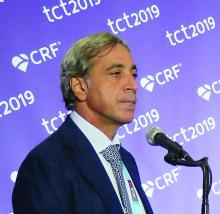SAN FRANCISCO – A urine flow rate (UFR)–guided approach was superior to the left ventricular end-diastolic pressure (LVEDP)-guided hydration regimen in preventing contrast-induced acute kidney injury and acute pulmonary edema in high-risk patients.
The results come from a randomized, multicenter, investigator-initiated trial designed to compare two hydration strategies for reducing the risk of acute kidney injury that Carlo Briguori, MD, PhD, presented at the Transcatheter Cardiovascular Therapeutics annual meeting.
Between July 15, 2015 and June 6, 2019, Dr. Briguori, chief of the laboratory of interventional cardiology at the Mediterranea Cardiocentro in Naples, Italy, and his colleagues enrolled 708 patients with an estimated glomerular filtration rate of 45 mL/min per 1.73 m2 or less and/or with a Mehran’s score greater of at least 11 and/or a Gurm’s score greater than 7. Of these, 355 were assigned to LVEDP-guided hydration with normal saline, while 353 were assigned to UFR-guided hydration controlled by the RenalGuard system. Iobitridol, a low-osmolar, nonionic contrast agent, was administered in all cases.
The primary endpoint for the trial, known as Renal Insufficiency Following Contrast Media Administration Trial III (REMEDIAL III), was the composite of contrast-induced acute kidney injury (defined as a serum creatinine increase of at least 25% and/or at least 0.5 mg/dL from baseline to 48 hours) and/or acute pulmonary edema. That endpoint occurred in 5.7% of patients in the UFR-guided group and in 10.3% of patients in the LVEDP-guided group (relative risk, 0.56; P = .036). As for side effects, three patients in the UFR-guided group (0.8%) experienced complications related to Foley insertion, including one case of hematuria and two cases of pain on micturition. No patients developed a urinary tract infection, Dr. Briguori reported at the meeting, which was sponsored by the Cardiovascular Research Foundation.
Hypokalemia occurred in 6.2% of patients in the UFR-guided group and 2.3% of patients in the LVEDP-guided group (RR, 2.70; P = .013), while potassium replacement was required in 5.1% of patients in the UFR-guided group, compared with 1.4% of LVEDP-guided patients (RR, 3.74; P = .009). Meanwhile, hypernatremia was observed in 1.2% of patients in both groups (P = 1.00).
“For the longest time, the interventional field has been trying to find ways to minimize acute kidney injury related to interventional procedures,” Juan F. Granada, MD, president and CEO of the Cardiovascular Research Foundation said in a media briefing. “We have a lot of data with multiple approaches with different results – mostly negative. This is important because, as procedures get more complex, longer, and contrast media is used, there is continuous interest in minimizing the potential kidney injury.”
A discussant at the briefing, Gary S. Mintz, MD, a senior medical adviser for the CRF, suggested a different approach to preventing contrast-induced nephropathy. “If you do imaging-guided zero-contrast percutaneous coronary intervention, you do not get contrast-induced nephropathy, period,” he said. “If you get rid of contrast, you get rid of contrast nephropathy. Anybody who has worked with patients who transition to dialysis understands that once you go on dialysis, your life changes for the worse no matter what you do. There has been no improvement in dialysis therapy in decades. But to me, the solution is to get rid of contrast, which can be done if you think differently and plan differently.”
For his part, Dr. Briguori said that he and his colleagues in REMEDIAL III “tried to use the least amount of contrast possible. The mean volume of contrast media in this trial was 70 mL, which is very low.”
The RenalGuard device (RenalGuard Solutions) is CE-marked for sale in Europe and is under investigation in the United States. The REMEDIAL III study was supported by an unrestricted grant from Guerbet (Villepinte, France) provided to the Mediterranea Cardiocentro. Dr. Briguori reported having no relevant disclosures.
SOURCE: Briguori C. TCT 2019, Late Breaking Trials 4 Session.


